My apologies to all my readers for the tardiness of this post. I fell behind yesterday, as it was my first day back from the New Year's holiday and I just wasn't able to get started on this post until today.
Today, I will complete my examination of the printings of the 6d mauve and claret Queen Victoria surface printed (keyplate) stamp of Lagos, as well as the final plate 2 printing, in which the duty plate colour was changed to aniline carmine.
The original colour printings, which ran until August 1901, fall into two groups:
Thirty Seventh Printing
Forty Seventh Printing
On this printing, the head plate colour is pale slate lilac and the duty plate colour is deep purple, that is just a touch brighter than the Gibbons shade. I have two used examples as shown above, The stamp on the right does appear somewhat brownish, but I believe that this is due to some light age toning of the paper. Both used examples are dated October 23, 1902 and January 1904.
The stamp on the right shows another flaw of the duty plate, which may be constant: the narrow topped "S" in "Six". In this flaw, the top curve of the "S" is notably narrower than the bottom curve, but the bottom curve is not especially thick. A close-up scan is shown below:
Forty Ninth Printing
The head plate colour of this printing is pale slate lilac and the duty plate colour is closest to Gibbons purple shade.
I have one mint, and one used example as shown above. As expected, the used example is cancelled with a 24 mm Lagos CDS cancel, dated July 1, 1901.
Fiftieth Printing
Fifty First Printing
Fifty Third Printing
The head plate colour of this printing is pale slate lilac, and the duty plate colour is closest to Gibbons's deep mauve.
I have one mint example, and two used examples, as shown above. Both used examples are cancelled with a 24 mm Lagos CDS, with one being dated sometime in 1903. However, neither cancellation is clear.
Fifty Seventh Printing
On this printing, the frame plate colour is closest to Gibbons' deep rose lilac, while the duty plate colour does not match any of the Gibbons swatches. It is an extremely deep magenta, being much deeper than the Gibbons deep magenta shade.
I have five mint examples as shown above, and seven used examples as shown below:
On this printing, the duty plate colour is the same as the last printing. However, the head plate colour, is also closest to Gibbons' deep rose lilac, but the colour is both paler and duller. So I would call this deep, dull rose lilac and very deep magenta.
I have six mint examples, as shown above, and twelve used examples, as shown below:
Today, I will complete my examination of the printings of the 6d mauve and claret Queen Victoria surface printed (keyplate) stamp of Lagos, as well as the final plate 2 printing, in which the duty plate colour was changed to aniline carmine.
The original colour printings, which ran until August 1901, fall into two groups:
- Those from the fourth state of the plate, in which all the detail in the hair at the back of the head is gone, and most of the hairlines at the top of the crown and the base have merged together, leaving a narrow band of clearly discernable hairlines in the middle of the head, just above the crown. The thickness of the horizontal shading lines in the medallion is are just beginning to show signs of wear, with their thickness being slightly uneven, but overall, they still look clear. Finally, the horizontal shading lines in the band of the crown are mostly clear, but are just starting to show some merging.
- Those from the fifth, and final state of plate 1. In this final state, there is an overall coarseness to the background printing in the medallion, with very clear differences in the thickness of the shading lines. Most of the hair at the top of the head has merged together, as have most of the shading lines in the band of the crown.
Group 4 - Printings From the Fourth State of the Plate - Printings 35-42 - Mid-1896 to Mid 1898
The group of printings from this state that I have identified is quite small. One distinguishing characteristic is that the duty plate colours tend, with one exception to be shades of either purple, plum or mauve. Only two of the printings have used examples cancelled with a barred oval grid, so its use during this period has declined considerably and given way to the wide 24 mm Lagos CDS cancel. All examples of that cancel (three examples) from this group are dated in 1900, which does suggest that stocks of earlier printings were still being sold and in widespread use during this period.
Thirty Fifth Printing
On this printing, the head plate colour is very close to Gibbons's deep purple and plum shades. I lean closer towards plum, due to the brownish undertone in the colour. It is just a touch paler, and duller than the plum, but not nearly as dull, as say, the deep dull purple on the Gibbons colour key. The duty plate colour is close to Gibbons's purple shade, but is both deeper and much brighter - similar to the mauve shade, but much deeper. I'd call it deep bright purple.
I have one mint and one used example, as shown above. The used example is clearly cancelled with a barred grid oval, though it is not possible to tell whether or not it is an 8, 9 or 10 bar oval.
Thirty Sixth Printing
This is one of four printings in this group for which I have no mint examples. The head plate colour is similar to the shade of the last printing, being a variant of plum, while the duty plate shade is closest to Gibbons's deep claret shade, but is much deeper.
Both used examples shown above are cancelled in 1900, with the date on the left one being illegible, but the one on the right being July 18, 1900.
Thirty Seventh Printing
The head plate shade of this printing is a variant of plum, being similar to printings 36 and 37, but being a little bit lighter. The duty plate colour is very similar to the very deep claret of printing 36 above, but there is a bit of brown in the colour. However, there is not nearly enough brown for it to be a shade of maroon.
I have no used examples of this printing, but only the mint example shown above.
Thirty Eighth Printing
This is another printing for which I have no mint examples. The head plate colour of this shade is much closer to a deep version of Gibbons' reddish lilac than it is to a shade of plum. The duty plate colour is very, very similar to the very deep claret shade identified earlier.
This example is cancelled with the 24 mm Lagos CDS dated, what appears to be January 8, 1900.
Thirty Ninth Printing
The head plate colour of this printing is quite bluish, being very close to Gibbons's slate lilac, but paler. So I would classify the head plate colour as pale slate lilac. The duty plate colour lacks the brownish undertone that is required for it to be a claret. It is actually closest to purple, but is just a touch paler.
I have only the sole mint example shown above, and no used examples.
Fortieth Printing
At first glance, the head plate colour if this printing is similar to the last printing in appearance, but then it becomes apparent that it is more reddish. It is actually closest in overall tone to Gibbons' plum, but is much paler - a pale plum. The duty plate colour is closest to Gibbons's deep purple, being an almost perfect match.
I have no used examples of this printing, but just the one mint example shown above.
Forty First Printing
This is another printing, for which I possess no mint examples. The head plate shade is very similar to the 39th printing, being a pale slate lilac. The duty plate colour is very distinct, being about mid-way between Gibbons' purple shade and Gibbons' deep magenta shade.
This single used example is cancelled with a bold strike of the Lagos 8-bar oval obliterator, being the last positively identified example of a 6d to bear this cancel.
Forty Second Printing
This is the last printing from this group, for which I do not possess any mint examples. The head plate colour of this printing is an almost perfect match to Gibbons's slate lilac. The duty plate colour is very close to Gibbons's deep purple, but is brighter. It is also an aniline ink, showing very clearly through the back of the stamp.
Group 5 - Printings From the Fifth State of the Plate - Printings 43-57 Mid 1898 to August 1901
In this group of printings we begin to see a real shift in the colour of the duty plate. For the several printings we see shades of purple or plum, but then the colour starts to take on more of a magenta appearance, acquiring more and more rose, until it becomes a cerise colour, before returning to magenta again. Also, but the time the last printings appear, the ink has become aniline. At 15 identified varieties, it is likely that a few of these are really from the same printing, given how close some of the head and duty plate shade combinations are. However, I have decided to identify them Separately anyhow, as it is possible that some of them fall into the 1897-1898 period.
The 24 mm Lagos CDS is found on all the used stamps that I have from this group except one. One stamp has what appears to be a 9-bar oval obliterator, though it could be a 10-bar oval from Ibadan. In terms of dates, all of the cancellations were dated between 1901 and 1904, which again suggests that surplus stocks from earlier printings continued to be used during this period.
In this group a new, possibly constant plate flaw appears, again involving the duty plate, which I call the "damaged "S" and "PE" of Pence". There is also a "narrow topped S" that makes its appearance as well.
Forty Third Printing
The head plate colour of this printing is close to the Gibbons dull purple, but is paler. So I would classify it as pale dull purple. The duty plate colour is a perfect match to Gibbons's purple shade.
The single mint example shown here shows considerable damage to the "P of "Pence". Upon closer examination, once can see additional damage, though not as prominent on the "S" and the first "E" of "Pence". I do not know if this is a constant flaw, as this is the only example that I have seen so far.
A closer scan of this flaw is shown below:
Forty Fourth Printing
The head plate shade of this printing is closest to Gibbons's plum shade, but is much, much paler, being more appropriately called the very pale plum. The duty plate colour however, is an almost perfect match to the plum shade.
I have two mint examples of this printing, one of which is not sound, and one used example shown on the right. This used stamp appears to have been cancelled with a double strike of a 9-bar oval obliterator. From the width of the cancellation (i.e. length of the bars) it would appear that it is an Ibadan cancellation.
Forty Fifth Printing
The head plate shade of this printing is another variation of dull plum. It is not brown enough to be the dull purple, but it is duller than the regular plum shade. So I would call it dull plum. The duty plate shade is very close to the pure plum shade.
I have no used examples of this printing, and only the single mint example shown above.
Forty Sixth Printing
The head plate colour of this printing is a very close match to Gibbons's slate lilac, but with a touch of rose. The duty plate shade is a very close match to Gibbons's deep purple.
I have no mint examples of this printing, but only the single used example shown above, which is cancelled February 7, 1901.
Forty Seventh Printing
On this printing, the head plate colour is similar in intensity to Gibbons's lilac shade, but the colour contains a definite bluish undertone. I would say that it is closest to what the slate lilac shade would be if it were lighter. So I would therefore call the head plate colour pale slate lilac. The duty plate colour is an almost exact match to Gibbons' purple shade.
I do not have any mint examples of this printing, and only the single used example shown above. This used stamp is canceled with a 24 mm Lagos CDS cancel dated November 2, 1901.
Forty Eighth Printing
On this printing, the head plate colour is pale slate lilac and the duty plate colour is deep purple, that is just a touch brighter than the Gibbons shade. I have two used examples as shown above, The stamp on the right does appear somewhat brownish, but I believe that this is due to some light age toning of the paper. Both used examples are dated October 23, 1902 and January 1904.
The stamp on the right shows another flaw of the duty plate, which may be constant: the narrow topped "S" in "Six". In this flaw, the top curve of the "S" is notably narrower than the bottom curve, but the bottom curve is not especially thick. A close-up scan is shown below:
Forty Ninth Printing
The head plate colour of this printing is pale slate lilac and the duty plate colour is closest to Gibbons purple shade.
I have one mint, and one used example as shown above. As expected, the used example is cancelled with a 24 mm Lagos CDS cancel, dated July 1, 1901.
Fiftieth Printing
The head plate colour of this printing is an almost exact match to Gibbons's plum, and as such it is the deepest and brightest colour in which the frame is found. The duty plate colour is closest to Gibbons's purple.
I have only the used example shown above. It is cancelled with the 24 mm Lagos CDS cancel, dated February 6, 1901.
Fifty First Printing
The head plate colour of this printing is closest to the Gibbons reddish lilac, but is a little deeper and duller than the shade shown on the swatch. So I would call it deep, dull reddish lilac. The duty plate colour looks magenta at first glance, but is actually about mid-way between the Gibbons purple shade, and the Gibbons deep magenta shade.
I have no mint examples of this printing, and only the used example shown above. This example is canceled with a 24 mm Lagos CDS cancel, dated March 11, 1901.
Fifty Second Printing
The head plate colour of this printing is closest to a deeper version of Gibbons's reddish lilac, so deep reddish lilac. The duty plate colour is an almost perfect match to Gibbons's deep mauve.
I have no used examples of this printing, but only the three mint examples shown above.
Fifty Third Printing
The head plate colour of this printing is deep reddish lilac, and the duty plate colour is an almost exact match to Gibbons's deep magenta.
I have no used examples of this printing, but only the single mint example shown above.
Fifty Fourth Printing
The head plate colour of this printing is very, very close to Gibbons's reddish lilac, but is just a little bit paler. The duty plate colour is about mid-way between Gibbons' deep magenta and magenta shades.
Again, I have only the single mint example shown above, and no used examples.
Fifty Fifth Printing
The head plate colour of this printing is closest to pale slate lilac, with a touch of rose. The duty plate colour is almost an exact match to Gibbons' bright magenta.
I have no mint examples of this printing. The used example shown above is cancelled with a 24 mm Lagos CDS cancel dated June 17, 1902.
Fifty Sixth Printing
The head plate colour of this printing is pale slate lilac, and the duty plate colour is closest to Gibbons's deep mauve.
I have one mint example, and two used examples, as shown above. Both used examples are cancelled with a 24 mm Lagos CDS, with one being dated sometime in 1903. However, neither cancellation is clear.
Fifty Seventh Printing
The head plate colour of this printing is pale slate lilac with a touch of rose, similar to the 55th printing above. The duty plate colour is an almost exact match to Gibbons's deep magenta.
Group 6 - Printings From Plate 2 - Printings 58 & 59 October 1902 to January 1904
There is only one recorded printing of this stamp from plate 2, which according to Gibbons, was issued in October 1902. This makes sense because it would have allowed for a period of just over a year between August 1901 and October 1902 for the surplus stocks of earlier printings to be used up. This explains why there are relatively few mint examples from group 5 and so many used examples, which is not usually the case in instances where there were a lot of remainders on hand in 1904. For this value, there were only 23,400 remainders that were sent back to London and destroyed, and it is probable that most of these are fairly evenly spread throughout all the printings that were sent to the colony, since the vast majority of the stamps that I have from this printing are all used. The exact quantity of this value is not known, but given that it was printed in late 1902, almost 16 months after Queen Victoria's death, it is a provisional issue that was only produced until the stamps bearing King Edward VII became available. Thus, one would not expect the quantity printed to be large.
This printing is easily identified by the fact that every detail of the design is clear and crisp, with every hair at the back and top of the head being visible, and no merging of shading lines whatsoever. This is of course, because a new plate has been put into use (plate 2) to produce the printing. The duty plate colour is described in Gibbons as carmine, but this is not really correct. It is actually a very deep shade of magenta and is printed in aniline ink that shows very clearly through the back of the stamps. I have identified two very slightly different shades of the head plate, one being of similar tone, but deeper than the other. This does suggest that two printings were made - very likely one in late 1902 and another sometime in 1903.
All of the cancellations except for one fiscal cancel are 24 mm Lagos CDS cancellations, and all are dated in 1903, which indicates that the stamps were used as they were sold. This suggests that the remainders that were sent back must have represented the stamps at the very bottom of the pile in most of the post offices throughout Lagos, at the time of their withdrawal in 1904.
I note an example of the "Fat bottomed S" among this group, which does indicate that this is indeed a constant flaw of the duty plate that was never corrected. Interestingly though, I have not found any examples of the "broken S" in this group, which suggests that it may well have been corrected.
Fifty Eighth Printing
On this printing, the frame plate colour is closest to Gibbons' deep rose lilac, while the duty plate colour does not match any of the Gibbons swatches. It is an extremely deep magenta, being much deeper than the Gibbons deep magenta shade.
I have five mint examples as shown above, and seven used examples as shown below:
All of these used examples shown here are cancelled with 24mm Lagos CDS cancels. Most of the cancels are not legible, but those that are, are dated in 1903 and 1904.
The last stamp shown above is another example of the "fat bottomed S" which was first introduced with the 19th printing. A close up scan shows the variety very clearly below:
Fifty Ninth Printing
On this printing, the duty plate colour is the same as the last printing. However, the head plate colour, is also closest to Gibbons' deep rose lilac, but the colour is both paler and duller. So I would call this deep, dull rose lilac and very deep magenta.
I have six mint examples, as shown above, and twelve used examples, as shown below:
There are some interesting cancellations included in the above group. The top left stamp is cancelled with a September 12, 1903 Great Britain Paquebot CDS, while the cancellation on the fourth stamp in the top row is some form of fiscal cancellation - likely from a passport or other legal document, which is unusual for this issue. The second from last stamp on the bottom is cancelled with the Lagos "Government Telegraphs" straight line cancellation, which is seen only occasionally on this issue.
The remaining cancels are all strikes of the 24 mm Lagos CDS cancellation, dated at various times in 1903.
This concludes my examination of the 6d Queen Victoria stamps of Lagos. The only values that remain in this series are the 1 shilling, which will be the subject of the next few posts, and the three high values: the 2/6d, 5/- and 10/- values, which will be examined after the 1s has been covered. From this point, I will tackle the two most difficult values of the series, being the halfpenny and 1d stamps.



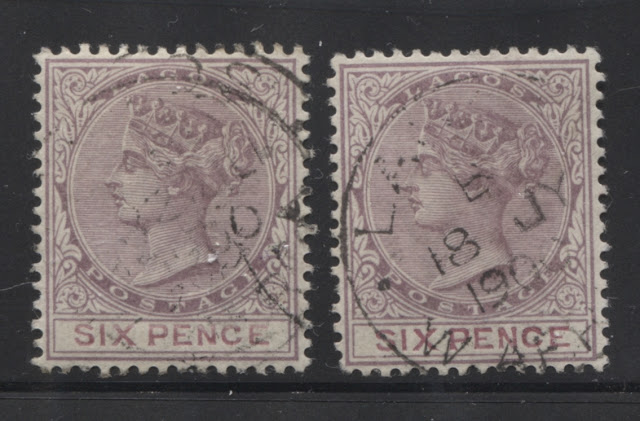


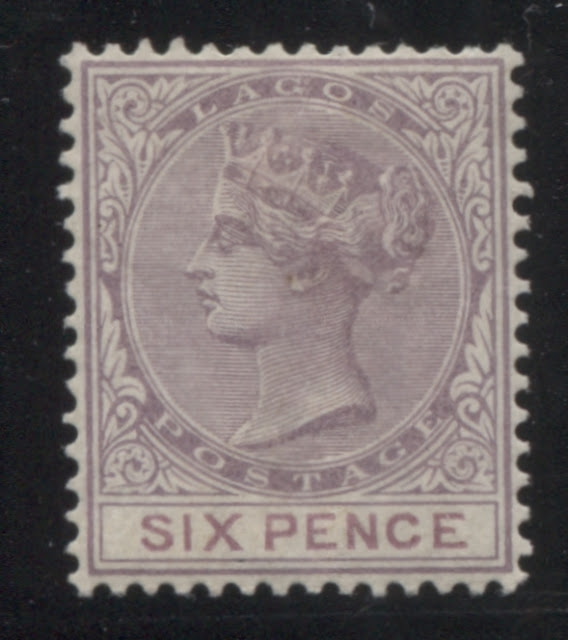

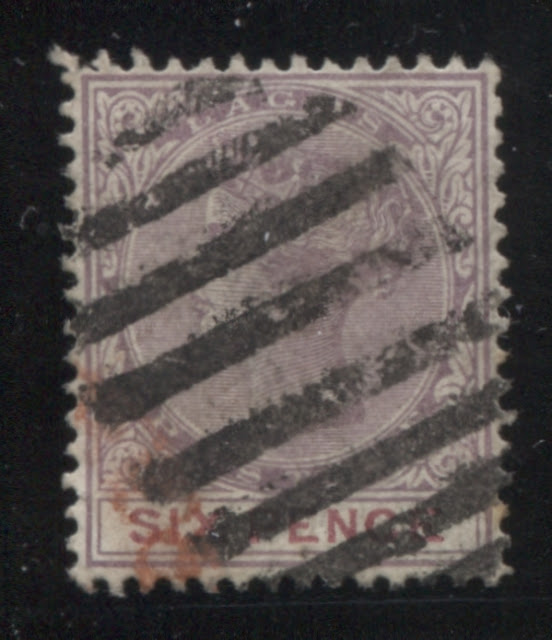

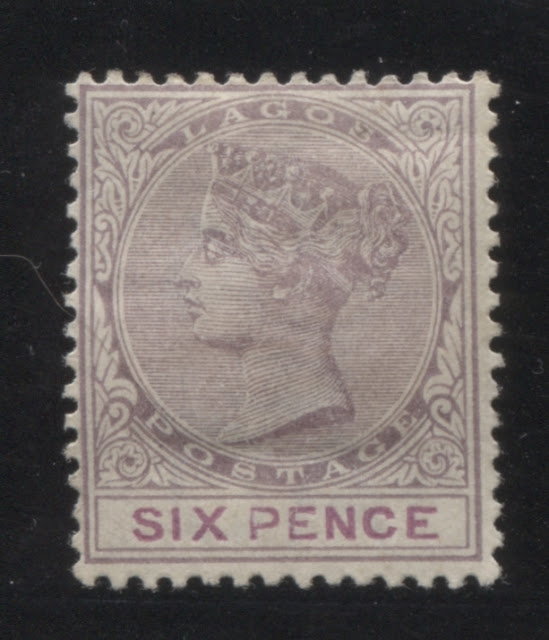
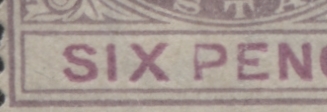

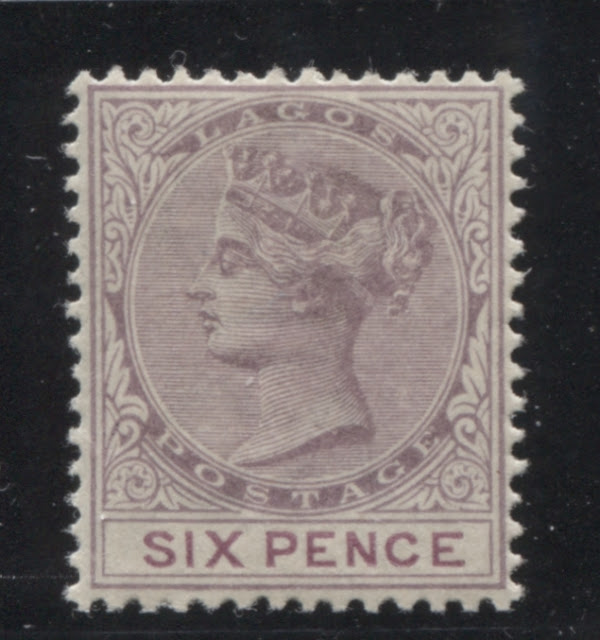



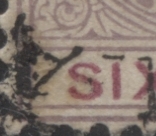







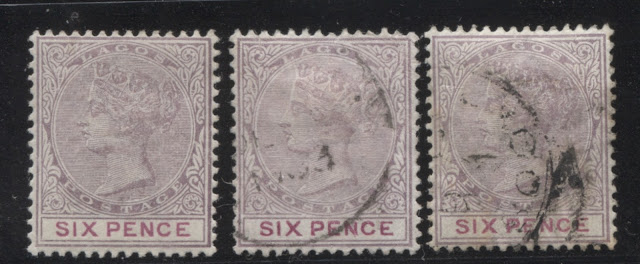

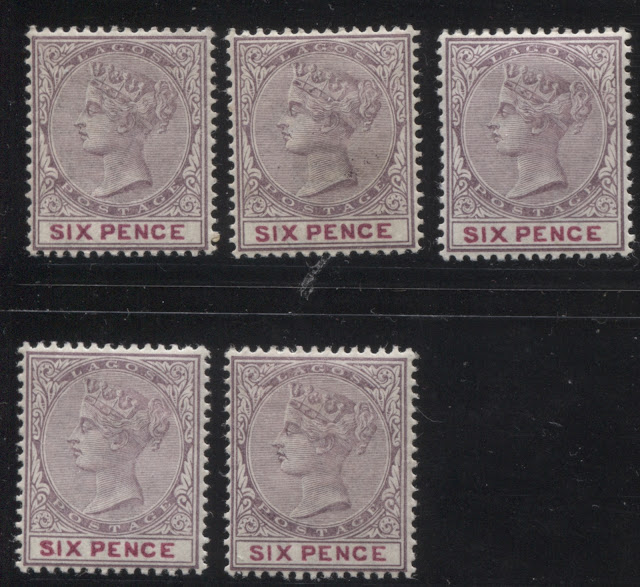
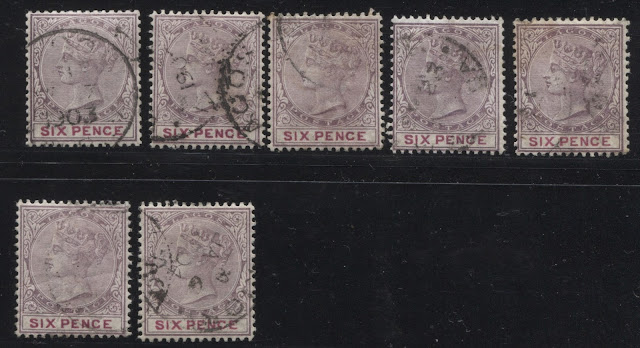



1 comment
http://gcialisk.com/ – real cialis no generic